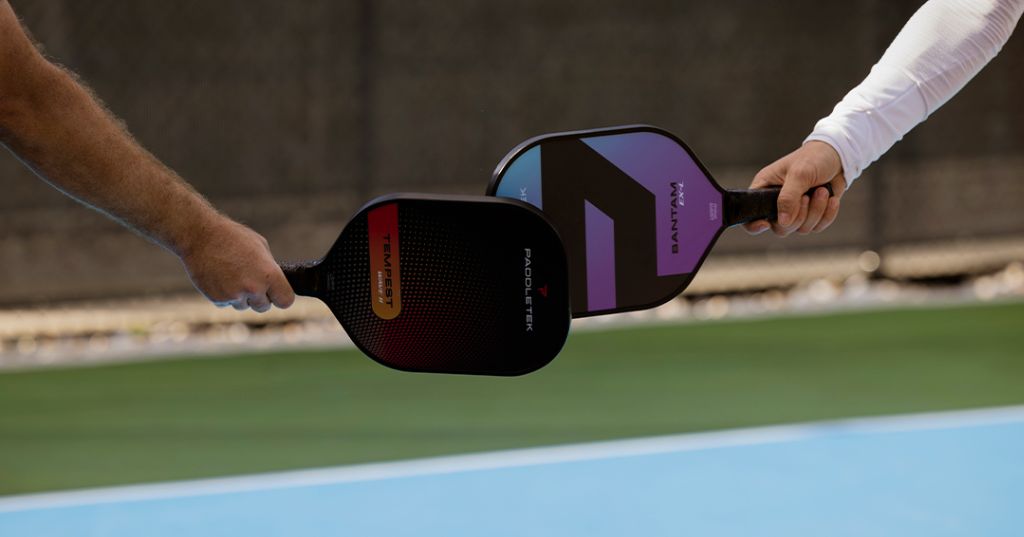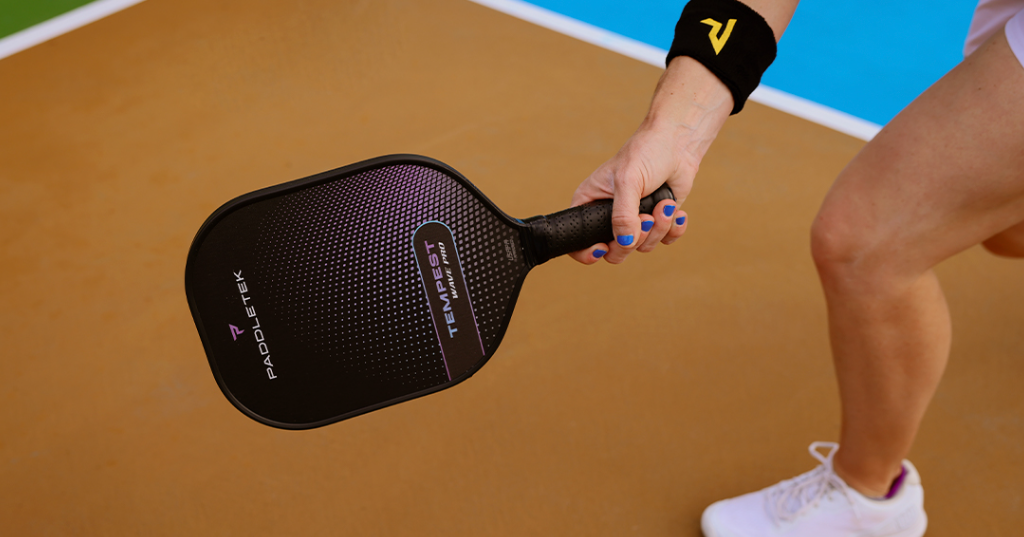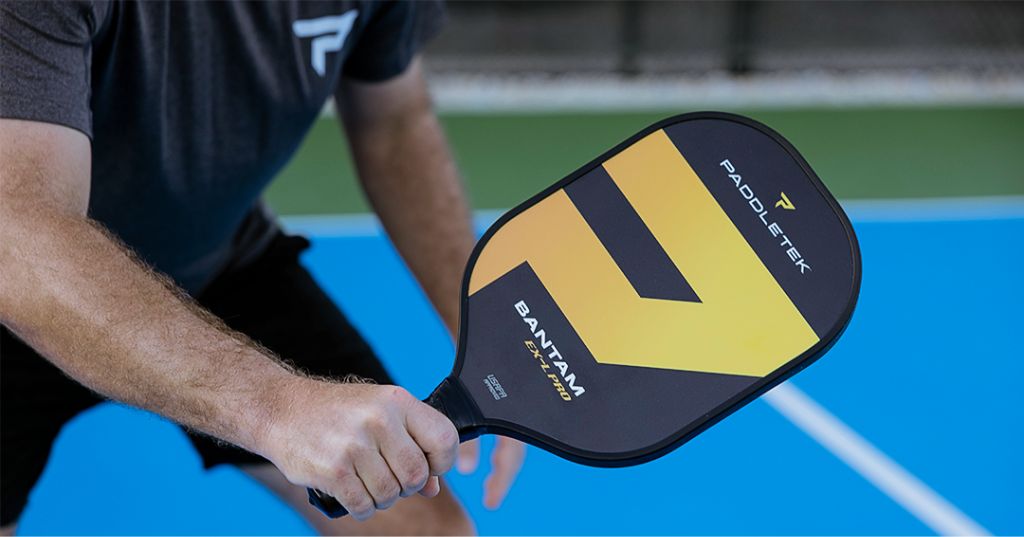If you've been playing doubles with the same partner for a while, you've probably developed a strong sixth sense, like moving in unison or not needing to verbalize your moves to each other. Those are both great accomplishments, but for many, pickleball milestones like this can spur a plateau, which is the perfect time to start focusing on other doubles strategies.
Here are 5 must-use strategies to incorporate into your doubles pickleball games:
- Communicate when returning shots in the middle of the court
- Avoid toeing the baseline during serve returns
- Go for the feet
- Begin incorporating more drop shots
- Practice patience and positivity
While this list was originally built with a seasoned team in mind, new partners who are still feeling each other out will benefit tremendously from all five strategies. So if you're looking to take your doubles game to the next level, give these 5 tips a try!
What Are the 5 Main Strategies Used in Doubles Pickleball?
1. Communicate When Returning Shots from the Middle of the Court
Let's act like you've reached a level in pickleball where you can tell what your partner is going to do, from how they'll hit the ball to where they're going to send it - you're on the same wavelength.
That's great, but you probably know that this level of silent understanding doesn't necessarily mean chaos won't ensue. And there's one place in particular that loves a chaotic time - the center of the court.
This is the not-so-sweet spot of the court where two paddles go for the same ball and paddle-clashing ignites. Well, either that or you get too close to your partner (and vice versa), and no one can make the shot accurately.
When two paddles go for the same ball, it's time to employ some strategic thinking and communication skills to avoid a friendly fire situation - and communication here can be verbal and nonverbal.
Rather than wait until you’re in the heat of the moment to decide who will take the shots down the middle, prepare for it before the game. It's a 30-second conversation that's absolutely worth the time.
A common strategy is to let whoever has the forehand in the middle, take the middle shots - you may need to only have this conversation once if you and your partner have a clear gap between forehands.
This can certainly change if your partner has a solid backhand to manage the center lane, is opposite-handed as you, or your opponents have varying shades of skills that require some adjustment on your side.
If things happen to change while you’re playing, then so be it. You can always rely on those old standby commands of “Yours” or “Mine” to communicate your intentions quickly and effectively.
2. Avoid Toeing the Baseline During Serve Returns
Everyone loves to get to the kitchen line in pickleball, but sometimes this eagerness can get the best of you on serve returns. Starting with your feet too close to the baseline can put you in a difficult position for your return.
When it comes to serve returns, the right positioning is key.
Obviously, the serve has to bounce before you return it, but if you get too close to the baseline when you’re returning a serve you'll likely find zero room between you and the ball. But if you keep your distance, running forward will be far easier than dragging yourself back for those deep serves.
So if you're crowding the baseline, the next time you're anticipating a serve, stand back from the baseline at least two feet. If you know your opponent has a strong serve, you can even go as far as three feet back to give yourself some extra room.
The only exception is if you anticipate that your opponent will hit a short serve - this is usually something you can expect based on what you've learned about them through playing, like their ability to serve deep or a combination of that and their inability to mix up serving depth.
If that's the case, then sure, stand closer to the baseline, but stay alert if you do - they could be baiting you into thinking that, before serving it deep.
Remember that your partner will be standing at the kitchen line while you receive the serve, so this only applies to them when they are receiving the serve.
3. Go for Your Opponent’s Feet
Here’s an old standby strategy that you can take from playing singles pickleball and easily implement into your doubles playing. Hit the ball at your opponents' feet!
It may seem like an easy hack, but strategically placing the ball below their ankles can make all the difference when it comes to making key points and winning games. One of the benefits of aiming low is that it doesn’t matter so much where on the court your opponent is standing, it will be viable and effective anywhere with any shot.
Going low will also make it a lot more difficult for your opponent to return your serve. The reason? The ball, at such a low altitude, may not pop back up as much.
A more experienced pickleball player might be able to return this low serve, but beginner players and even some intermediates won’t be capable enough.
The best method for aiming at the feet when dinking the ball is to use an open paddle face and gently push or lift the ball. A good dink is both controlled and puts pressure on your opponent to move to return it.
If you have any backswing at all, keep it minimal because you generally need more placement than power. Big backswings also are easier to read for your opponent and take more time to bring your paddle back to the ready position.
We also like hitting near the opponents’ feet when they’re close to the baseline, as this can impede their ability to progress to the kitchen line. It's also effective when your opponent is between the baseline and non-volley line, in the transition zone.
Hopefully, by now you can see why this strategy truly works anywhere on the court. As with anything in pickleball, use low shots strategically and with different angles so you don’t become too predictable.
4. Begin Incorporating More Drop Shots into Your Game
Mastering the drop shot is key if you want to be a top-tier pickleball player. It takes time and practice to perfect, but it's well worth the effort — your opponents won't know what hit them!
One of the most common times to hit a drop shot is right after the two-bounce rule has been observed, which is on the third shot. That’s why you also hear of drop shots referred to as a third-shot drop. It is also common to see players try a drive on their third shot, then use the drop on their fifth shot.
A sly drop shot can keep your opponents on their toes and give you the upper hand during doubles, but the reason that drop shots are tricky is twofold.
For one, you don’t hit a drop shot very hard. As the name suggests, your goal is to “just kind of drop it in” behind the net into the kitchen. In other words, letting off the gas too much will end in the net, giving your opponent a freebie. Second, you have to hit accurately when doing a drop shot. Hit it too high and you’ve set your opponent up for an easy smash.
Hit it just right then your opponents have to follow up with a shot from the non-volley zone line. Hitting a drop shot to their backhand makes it even harder for them to handle.
A good strategy for drop shots is to think about them more like long-range dinks. A good dink and drop shot both lands in the kitchen.
So to practice your drop shot, begin by practicing your dinks. Starting with dinks at the kitchen line, keep moving back until you can successfully drop your shot into the kitchen from the baseline. Once you’ve got that down pat, you can start trying to hit drop shots off of serve returns in games or anytime you’d like to get into the kitchen line.
Using drop shots makes it easier for you to reach the kitchen because if done properly, they are hard for your opponent to attack, which will at least buy you a bit of precious time, or in the best case, give your team the rally.
If you’re having a tough game and you’re hoping to turn things around, this could be the shot that does it.

5. Practice Patience and Positivity
When you play singles pickleball, it's all on you - wins and losses are down to your own decisions and effort.
But when you join forces with a partner and move on to doubles, the game takes on a whole new dimension. You may have control over your own moves, but sharing the court with someone else means that their decisions will also influence events on the court.
Celebrate your successes and take responsibility for any missteps - but don't forget that in doubles pickleball, there's always a little bit of luck involved! The main ingredients to successful doubles teams are patience and trust
Be patient with your partner and trust their skills - apply that same logic to yourself as well. This means resisting the urge to make a shot happen if your partner may have a better angle on it, knowing when to hit with more power or less, and trying to call balls in and out for your partner, especially on serves.
Remember, faults are errors. So a simple way to think about this in doubles is that your risk of errors is twice as high when you have a partner on the court. Sometimes it’s better to think things over for a second and then act than it is to act too impulsively.
If you want to build a solid partnership, try celebrating every point, no matter the outcome. Tap your partner's paddle after each victory or defeat - it's a great way to stay positive and motivated while sharpening the camaraderie between you and your teammate.
Whether you or your partner makes a mistake or an incredible shot, each instance is a chance to say good job or let's go.
You'll inevitably stumble while playing doubles pickleball, but don't see it as a setback. Be honest about your mistakes and let your partner do the same to lower the risk of making the same mistakes again.
Instead of laying blame, take that opportunity to grow and learn together - who knows, you might even surprise yourself by winning the next point by learning from what caused you to lose the last point.

The Best Doubles Pickleball Strategy Is Shared
Now that you’ve seen an excellent smattering of doubles pickleball tips and strategies, it’s time to talk these over with your partner and pick one strategy to incorporate. Then you can add more and more strategies.
If you want to learn how a pro approaches an important element of doubles, then this is the perfect time to check out Christine McGrath's guide to stacking. You won't find a more qualified coach on the matter.
Even if you have a successful strategy at hand, if you’re the only one who’s using it, then you've missed the general spirit of this article. Being on the same page with your partner is crucial if you want to begin racking up those wins. Plan as a team, play as a team, and you’ll win as a team!



Leave a comment
This site is protected by hCaptcha and the hCaptcha Privacy Policy and Terms of Service apply.